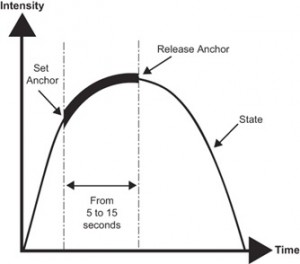Feeling self-confident and at your best
Have you ever wished you could feel at your best, confident, calm or energised, almost at the click of your fingers? With an NLP technique called ‘anchoring’, you can.
Overview
Put simply, an ‘anchor’ is a stimulus that leads to a response. For example, when you hear the first few notes of your favourite dance song, you probably feel energised and happy. Likewise, if you see your best friend’s face, you probably feel happy or a similar positive feeling. These stimulus-response links have already been set up during previous experiences. The purpose of anchoring is for you to set up your own stimulus-response link(s), and activate them when you want to, not when your friend happens to walk in or the DJ happens to play the song.
Why is this useful for you?
Once you have set your anchor, you’ll be able to use it before or during the following situations:
- presentations
- pitching for business
- negotiations
- interviews
- challenging meetings
- sporting competitions
- exams
- and any situations when it would be useful to feel at your best and/or relaxed
Once you have learned the anchoring process you will be able to feel the way you want to, and also help people feel the way they want to.
Please remember that anchoring is suitable for relatively minor situations, not where you feel a very strong emotion like anger, rage or panic.
What is an Anchor?


An anchor is a stimulus that creates a response in you or another person. Therefore the process of anchoring is using a memory of a positive situation to produce a positive state of mind which you can use in future situations such as those mentioned in the previous paragraph.
All memories work on the same principle; Think of your strongest memories; your first day at school, your first kiss or festive times with your family, the strength and depth of the memory is determined by the intensity of the experience.
How anchoring works
The following diagram shows how anchoring works.

Anchors can be created from sensory experiences i.e. experienced we have seen, heard, felt, smelled or tasted, or a combination of these.

If you remember a time when you felt, for example, really confident, and re-live that specific event in your mind, your state will intensify, reach a peak (typically for 5-15 seconds) and then you will return to your natural state. If you capture the peak of the state, (shown by the thin line) by linking it to a specific movement such as squeezing your thumb and index finger together, and repeat this process (typically four to six times), the state and the movement will become neurologically linked; so that if you repeat the finger/thumb movement before or during a business meeting you will feel in the state you have anchored (i.e. confident).
Tips:
- Make sure you re-live an intense, 9 or 10 out of 10 experience.
- Capture the peak of the experience (as explained in the previous section).
- Make the anchor unique, something you would only do or say when you want to activate the anchor.
- Make sure you can activate the selected anchor when you want to, and only when you want to. For this reason many people prefer to select a kinaesthetic anchor.
The anchoring process
- Decide on between two and four states you’d like to anchor. Remember between one and three times when you felt each of these (around 6 events in all). Decide on the movement or word/phrase you want to use (e.g. thumb and index finger if a movement, ‘go for it’ if a phrase)
- Pick one event. Re-live it fully, seeing, hearing and really feeling the event.
- Make sure you fully re-live the experience as if it were happening now.
- At the peak of the experience, anchor it. Release the anchor after the peak.
- Clear your mind by moving around or thinking of something completely unrelated.
- Repeat steps 2-5, for different events and desired states, using the same anchor, so that you do the process around six times in all. Depending on the number of states you wish to anchor, each state will be anchored one to three times.
- Test by repeating the phrase or the movement. You should ideally feel in the state(s) you anchored.
You can further re-inforce the anchor by doing mental rehearsal or visualisation. This consists of two main steps:
- Imagine seeing yourself on a TV or cinema screen. Activate your anchor and see yourself in different scenarios of the upcoming situation (interview, presentation etc.), feeling at your best, each time you achieve a successful performance/outcome, regardless of the scenarios. Notice what you did to perform so well.
- Repeat the previous set of visualisations, except that instead of seeing yourself, you imagine it is happening right now.

One final step would be to ‘top up’ your anchor by repeating the anchoring process at least once daily for several days, and also in the moment whenever you naturally experience the desired state(s).
Concluding comments
Anchoring is the application of a simple concept ‘memory’ and how, through neuro-associative connections, an environmental, physical or mental trigger can stimulate a separate emotional or physical response.
Anchoring is used to elicit resourceful states that are already within us, empowering ourselves and developing our resources. This article has given you the steps and some background from the NLP-based anchoring technique in around 900 words. If you would like a more extensive explanation of anchoring and other state control methods, our e-book will shortly be available for £1 on www.thelazarus.com






